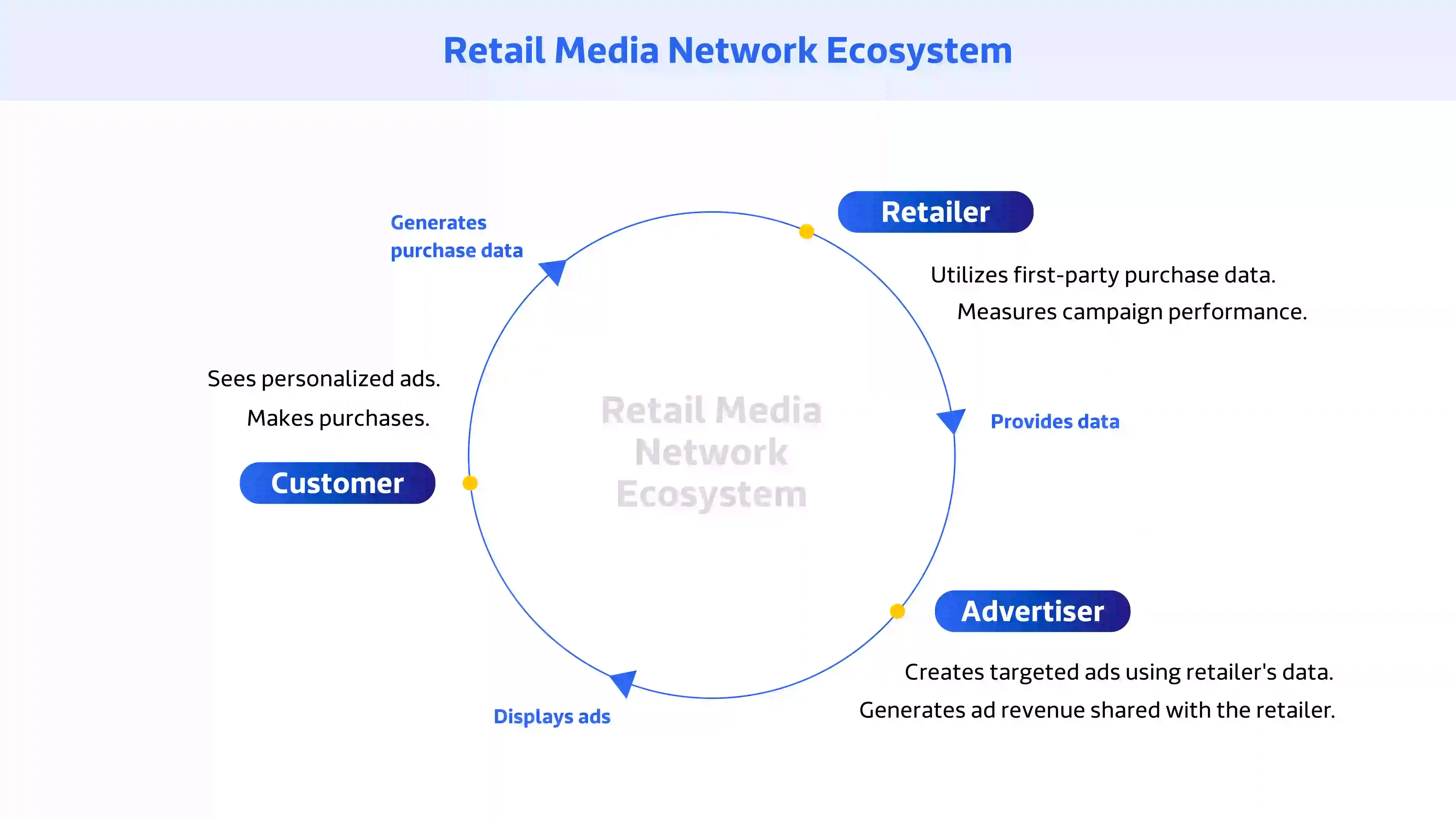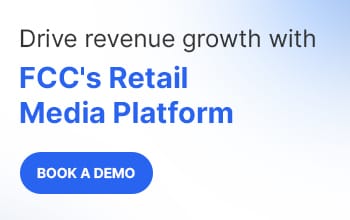Table of Contents
- What is retail media?
- Example of retail media
- Why is there so much excitement about retail media?
- What is a retail media network?
- How do retail media networks work?
- What are the different retail media ad formats?
- Benefits of having a full-proof retail media strategy
- Conclusion
What is Retail Media?
Retail media involves retailers offering advertising capabilities and services, similar to traditional media outlets like publishers and TV networks. Retail media ads range from on-site opportunities, such as ads and videos on the retailer's website, app, or physical stores, to off-site advertising, where retailers leverage first-party data to reach customers on third-party channels like social media.
The convergence of digital media and retail is reshaping how brands connect with relevant audiences, often through commerce media channels like Prime Video and Roku, creating a unique blend of entertainment and shopping. Off-site retail media is more complex and typically offered by mature retail media networks. Additionally, advanced retail media networks provide services like data analytics, self-serve advertising platforms, and campaign management. The growth of retail media is substantial, with digital retail media advertising spending in the US estimated at $46 billion in 2023. This figure is projected to more than double by 2027, accounting for around 11% of global ad spend.
Example of retail media
An example of retail media is Walmart Connect, Walmart's retail media network. Walmart Connect offers on-site and off-site advertising opportunities, leveraging Walmart's first-party data to target consumers effectively. It includes ads on Walmart's website, app, and physical stores, as well as off-site ads on third-party platforms like social media. In 2023, Walmart Connect's ad revenue grew significantly, with sponsored search spending increasing by 63%.
Another example is Target's Roundel, which uses Target's rich insights to create personalized advertising campaigns across its platforms and over 150 premium publishers. Roundel has delivered over $1 billion in value for Target. Retailers like Home Depot and Best Buy have also tapped into this growing retail media ecosystem, launching their own retail media campaigns to capture ad dollars and optimize ad placements across their platforms.
Why is there so much excitement about retail media?
The rise of retail media has been so significant that Insider Intelligence has termed it the 'third big wave of digital advertising,' following search and social media advertising. An increasing number of experts are recognizing retail media as one of the most effective methods of commerce marketing.
Retail media enables retailers to tap into new revenue streams using their existing channels and first-party data. With the integration of loyalty programs and loyalty cards, retailers can further enhance targeting, providing more precise ad placements and ensuring the ads resonate with relevant audiences. This shift comes at a time of major disruption in marketing, with traditional TV viewership declining and the phasing out of third-party cookies, which marketers have relied on for targeting digital campaigns.
What is a retail media network?
A retail media network is an advertising platform owned and operated by a retailer, allowing them to publish ads on their digital channels, such as websites and apps. These networks leverage first-party shopper data to personalize ads and target consumers effectively.
Retail media networks provide a new revenue stream for retailers and offer brands valuable consumer insights. They enable seamless integration of ads into the shopping experience, enhancing visibility and engagement. In fact, in 2023, retail media networks grew at twice the pace of social media advertising, with a projected ad spend of $45 billion. Companies like Google and The Trade Desk are actively collaborating with retail media networks to expand the reach of their ad platforms, pushing the boundaries of traditional advertising formats.
How do retail media networks work?
Retail media networks offer a straightforward approach for marketers to reach consumers directly through a retailer's channels. These networks allow brands to purchase advertising across a variety of digital platforms, including the retailer's own websites and apps, as well as third-party channels that partner with the retailer.
By expanding their reach beyond their owned properties, retailers can collaborate with media companies to offer ad space to third-party brands and activate additional digital assets. For instance, integrating digital ads on their websites creates a seamless engagement for shoppers online. This strategic approach positions retail media as the digital equivalent of in-store advertising, making it a valuable component of modern marketing strategies.
What are the different retail media ad formats?
Retail media offers a diverse range of advertising formats and sponsored content. Three primary ad types dominate this space:
- Sponsored Products: These ads seamlessly integrate into organic search results, appearing as sponsored products. Advertisers select products from the retailer's catalog to promote, and these ads are displayed when shoppers search for related terms. However, the specific relevance of search terms can vary across different retailers.
- Purpose: Lower-funnel tactic to capture shoppers at the point of purchase.
- Placement: Search results pages, homepages, and product detail pages.
- On-Site Display: Similar to traditional digital display ads, these ads appear on retailer pages, often in familiar formats. They can be strategically placed on high-visibility areas like homepages or product detail pages.
- Purpose: Mid-funnel tactic to engage shoppers while browsing and encourage product consideration.
- Off-Site Display: Leveraging the same retailer data as sponsored products and on-site display, off-site display (or off-site audience extension) targets shoppers in the early stages of the purchase journey.
- Process: Shoppers visit a retailer site but don't purchase. Later, they see ads for the browsed products on publisher sites or the open web. Clicking the ad returns them to the retailer's page to complete the purchase.
- Purpose: Upper-funnel tactic to drive awareness, bring back shoppers, and encourage product consideration.
Additional ad formats, such as CTV (Connected TV) and digital ads on platforms like NBCUniversal and Roku, allow brands to extend their retail media campaigns across various digital touchpoints, driving a seamless, omnichannel shopping experience.
Benefits of having a full-proof retail media strategy
A well-executed retail media strategy offers several advantages:
- Increased Sales: By reaching customers at the point of purchase, retail media can drive conversions and boost sales.
- Enhanced Brand Visibility: Retailers can showcase products to a highly targeted audience, increasing brand awareness and recall.
- Improved Customer Experience: Personalized advertising through retail media can enhance the shopping experience and build customer loyalty.
- Data-Driven Insights: Retail media provides valuable data on customer behavior, allowing for more effective marketing campaigns.
- Monetization Opportunities: Retailers can generate additional revenue by selling advertising space on their platforms.
A robust retail media strategy also allows brands to optimize their ad budget and placements, ensuring every ad dollar is spent efficiently. Metrics from these campaigns provide actionable insights that can be used for continuous improvement and retargeting strategies. As highlighted by industry leaders like McKinsey, Forrester, and experts like Lipsman, the traction retail media is gaining underscores its vital role in the future of digital marketing.
Conclusion
Retail media has emerged as a powerful tool for brands to connect with consumers at the point of purchase. By leveraging retailers' platforms and data, marketers can effectively target audiences, increase brand visibility, and drive sales. As the retail landscape continues to evolve, retail media will remain a crucial component of successful marketing strategies.
FAQ
Retail media empowers brands to strategically place ads on a retailer's ecommerce platform or app, influencing customer decisions at the crucial point of purchase. This innovative model elevates brand visibility on the digital shelf, similar to the prominence of endcaps or in-aisle displays in physical stores.
An example of a retail media ad is a sponsored product listing on Walmart's website. These ads appear natively within search results and are marked with a 'Sponsored' tag. Advertisers select products from Walmart's catalog to promote, and these sponsored listings are shown when shoppers search using relevant terms, enhancing product visibility and driving conversions.
The largest retail media network is Amazon Advertising, which dominates the market with around 75% of retail media ad revenue share. Following Amazon, Walmart Connect is the second largest, followed by Instacart, eBay, and Etsy. These networks leverage first-party data to provide targeted advertising opportunities for brands, driving significant revenue and consumer engagement.
Retail media differs from traditional media in several ways. Retail media leverages first-party data from retailers to deliver personalized ads directly to consumers at the point of purchase, enhancing targeting accuracy and engagement. Traditional media, on the other hand, relies on broader audience data and often uses third-party cookies for targeting.
Retail media integrates ads seamlessly into the shopping experience, while traditional media includes channels like TV, radio, and print, which are less interactive. Retail media also offers real-time performance measurement and optimization, unlike traditional media.
Investing in retail media offers numerous benefits. It provides retailers with new revenue streams by monetizing first-party data and digital assets. Retail media enhances customer experiences through personalized and engaging ads, increasing customer loyalty and satisfaction.
It offers valuable insights for data-driven decision-making and improves inventory management. Additionally, retail media strengthens brand partnerships, driving incremental value.


